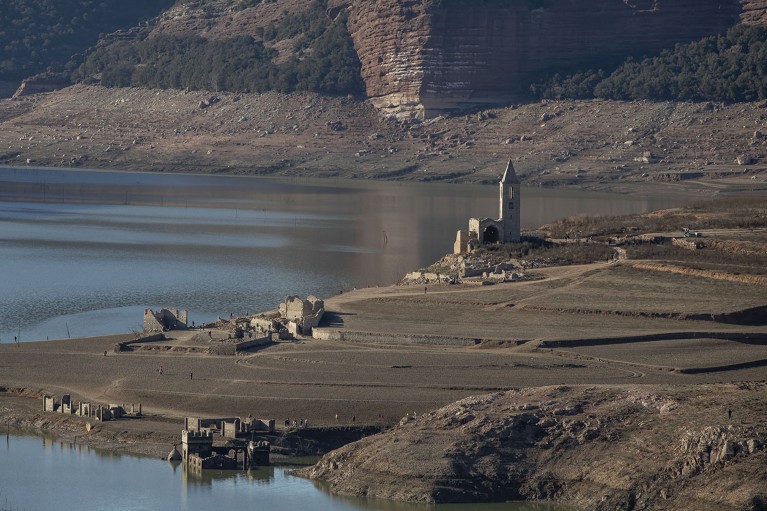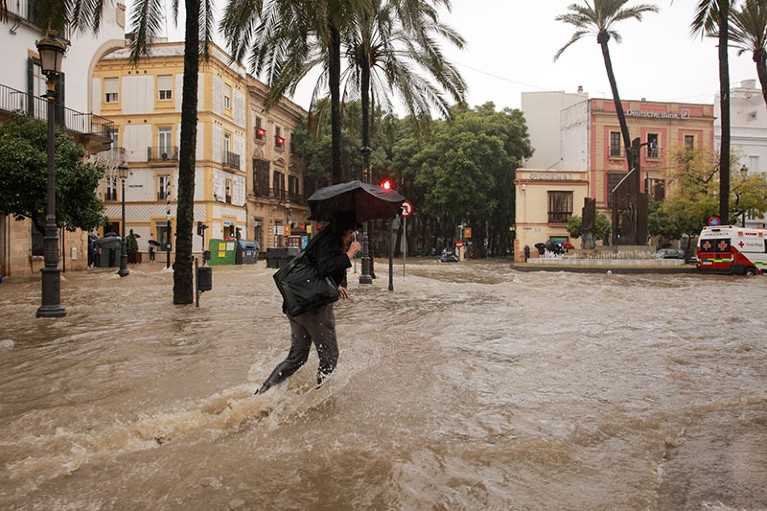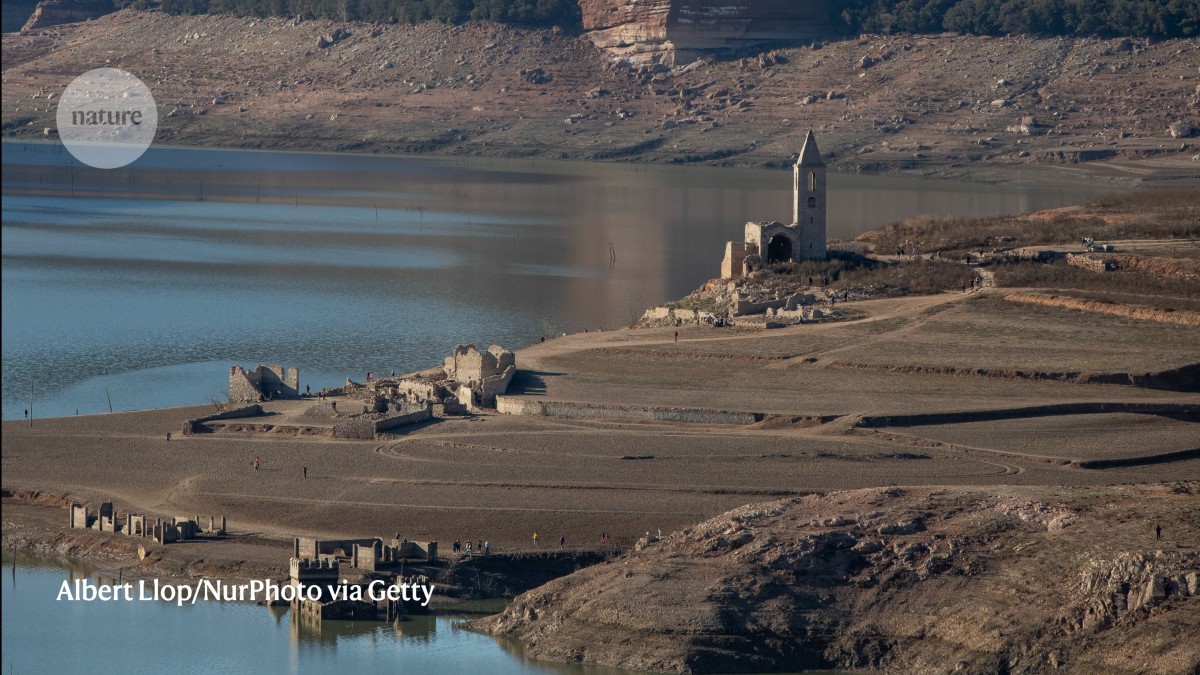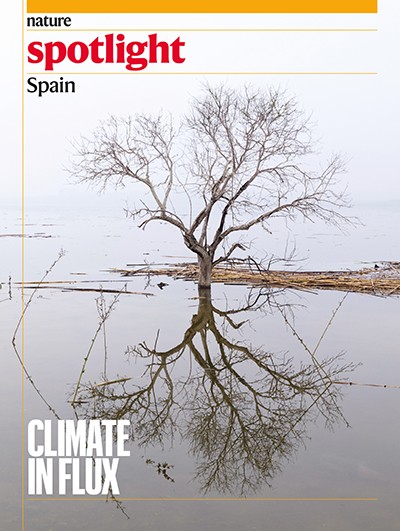
Ruins of an eleventh-century church were revealed when water levels in the Sau Reservoir in the province of Barcelona fell to record lows between 2021 and 2024.Credit: Albert Llop/NurPhoto via Getty
Last November, at the 29th Conference of the Parties (COP29) in Baku, the Prime Minister of Spain, Pedro Sánchez, stood before assembled world leaders with a stark warning: “climate change kills”.
Weeks earlier, on 29 October, flash floods had swept the Spanish regions of Valencia, Castilla-La Mancha and Andalusia, killing more than 200 people. In the torrential rains caused by a high-altitude isolated depression, or DANA event, some areas were pummelled with more rainfall in a few hours than they usually receive in a year. This was a new reality, Sánchez said, one that had “gone from academic articles to our televisions and windows”.
“The only thing that is as important as helping the victims of this terrible tragedy,” he added, “is to prevent it from happening again.”
Days after the floods, the government introduced a law that gives workers up to four days of paid leave in cases of extreme weather and requires all companies to prepare plans for climate-related emergencies. In Madrid, employees at the Ministry for the Ecological Transition and the Demographic Challenge (MITECO) work to manage Spain’s climate adaptation plans.
Nature Spotlight: Spain
“We know that practically all of these floods were related to bad urban planning,” says Sara Aagesen, third vice-president of the national government and head of MITECO. Spain’s increasing urban development on floodplains has made the land impermeable to rainwater, and concrete foundations and underground garages further restrict natural drainage. Aagesen says importance must now be placed on rebuilding responsibly and integrating nature-based adaptation measures. This includes recovering the space around river channels and increasing the permeability of the terrain. In Alicante and Barcelona, ‘floodable parks’ — green spaces that are designed to hold flood water and aid its gradual drainage — have been developed.
The Climate and Ocean: Variability, Predictability and Change programme in Spain, or CLIVAR-Spain, is a research collaboration sponsored by the Spanish Climate Change Office at MITECO. Its recent report1 on the state of the climate in Spain paints a serious picture: the country has already experienced significant warming since the 1960s, and both heatwaves and droughts have become more frequent and intense. These trends are expected to continue, with temperatures in Spain increasing 1.6 times faster than the global average. Under high-emission scenarios outlined in the Intergovernmental Panel on Climate Change Sixth Assessment Report2, temperatures could rise by up to 4 °C by the end of the century, with severe impacts on people’s health and productivity.
Along with a decrease in average precipitation in Spain, the CLIVAR report projects an increase in the frequency of extreme precipitation events, leading to greater risk of wildfires and floods. Overall, it predicts deteriorating conditions for two of Spain’s prominent industries: tourism and agriculture. Addressing these problems is not something Spain can do alone. “Climate change is a global challenge,” says Aagesen. “It requires a global response. Today more than ever, cooperation between nations is fundamental for Spain and for the world.”
Weathering the storm
Rapid attribution studies3 on the October DANA event linked the severity of the storm to human-driven climate change. These kinds of storm over Spain’s Mediterranean coast are now 15% wetter, producing a further 7 millimetres of precipitation per day, than past storms. Other studies have reached similar conclusions: a 1.3 °C increase in temperature from pre-industrial levels has doubled the likelihood of such storms.
Mireia Ginesta, a postdoctoral researcher at the University of Oxford, UK, has witnessed Spain’s shifting weather first-hand, having grown up in Barcelona. Now, she studies extratropical storms and the factors that drive them. “The temperature of the oceans, including the Mediterranean Sea, is rising, which means the air can carry more water vapour,” says Ginesta, “which in turn can increase a storm’s intensity.”

In October last year, heavy thunderstorms and flash floods hit parts of Spain.Credit: Juan Carlos Toro/Getty
From 2021 to 2024, Catalonia experienced some of the worst drought conditions in its history, during which water levels in the Sau Reservoir in the province of Barcelona fell to record lows, revealing the ruins of an eleventh-century church. The southern region of Andalusia has struggled with drought conditions since 2016, punctuated by short periods of intense rainfall.
Ginesta says that although prolonged droughts bring their own challenges, they might also have contributed to the catastrophic impact of the DANA. “If you suddenly have heavy rainfall after a drought, it’s not a relief: rainfall in soil that is already dry can produce huge flooding in an area.”
Pedro Zorrilla, a climate-change campaigner at Greenpeace Spain in Madrid, said his family has also experienced changes.
“My sons are not living in the same Spain that my parents lived in when they were their age,” he says. “The heatwaves in the summer are horrible and long. This wasn’t normal a few years ago.”
In the aftermath of the DANA, political mudslinging (some of it literal) has dominated the conversation. Zorrilla laments that fighting between parties has overshadowed a discussion of the problems, or what must be done now to avoid worse consequences in the future.
Misinformation and hoaxes have been another obstacle to productive discourse. For Aagesen, misinformation is one of the greatest threats facing our society. “Networks full of false information contaminate the possibility of making well-informed decisions,” she says.
In the height of the droughts of 2023, claims proliferated on social media that the Spanish government was deliberately destroying dams or emptying water reservoirs to declare a drought emergency. This narrative was repeated by the Spanish far-right party, Vox, during the election cycle that May. The conspiracy theory reappeared among the surge of misinformation in the wake of the DANA, claiming that the destruction of dams and reservoirs caused the flooding. These claims have been thoroughly debunked by Maldita, an independent news platform and verified member of the European Fact-Checking Standards Network. No reservoirs or large dams were destroyed in the Júcar river basin, the area most affected by the floods, which includes the province of Valencia. The only similar demolitions in the past 25 years have been small river barriers which had become obsolete.
The green revolution
Spain has every incentive to take rising temperatures seriously. “The Mediterranean basin is considered a hotspot — a region that warms faster than others on the globe,” explains Ginesta. “So these countries, including Spain, will experience the consequences of rising temperatures sooner than other parts of the world.”
Spain updated the targets in its National Energy and Climate Plan (NECP) in September last year4, including the goal of reducing net greenhouse-gas emissions by 55% compared with 2005 levels. As of 2023, it has achieved a 39% reduction in net emissions, surpassing the European Union average of 31%.



